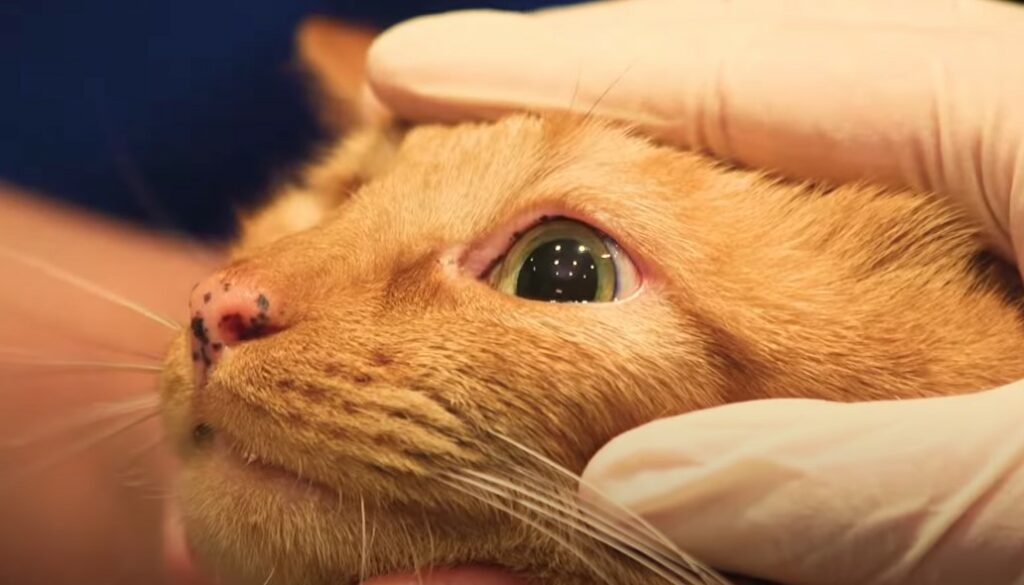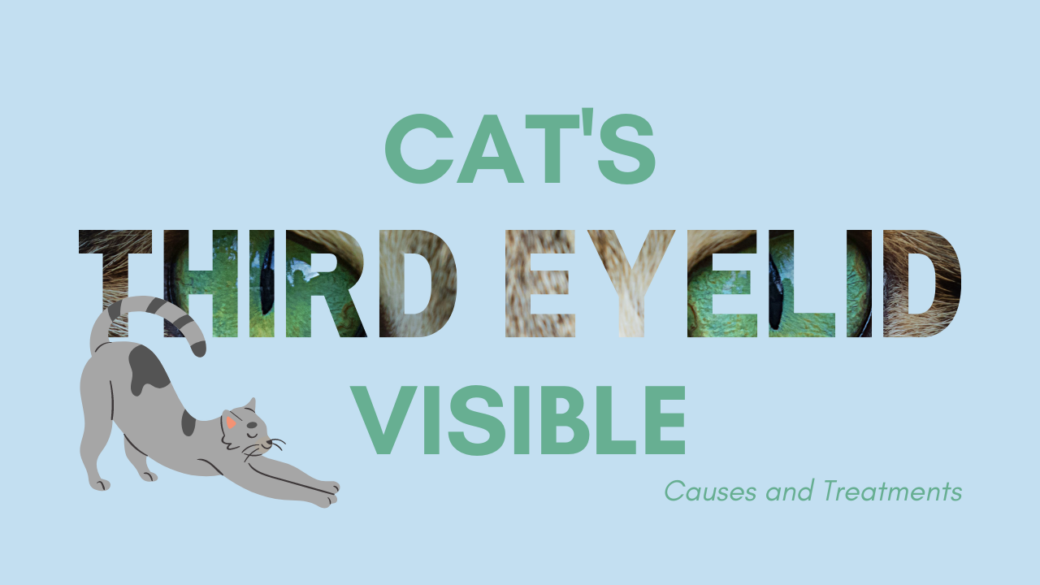Many pet owners are utterly entranced by cat eyes; the different colours, unusual pupils, reflective quality, and even the shape of their eyes are unique to these animals. Another distinctive feature cat eyes have is that they have not one, not two, but three eyelids. This might be a surprise to you, as it is rare for a cat’s third eyelid to be visible.
Cats’ eyes contain a retractable membrane at the inner corner, which is known as the third eyelid. It is possible some cat owners have never noticed this part of their pets’ eyes before, as it is commonly a sign of health issues. If you have noticed your cat’s third eye is visible, then this article will be worth a read.
Table of Contents
What is a Cat’s Third Eyelid?
The third eyelid is known by the scientific name nictitating membrane. It is the semi-transparent tissue around the conjunctiva, cornea, and mucous membrane, differentiating between the upper and lower eyelids. The membrane can be drawn across the eye instinctively to protect and moisturise the cat’s eye while maintaining good vision, similar to a windscreen wiper. It is usually hidden in the inner corner of the cat’s eyes.

Other animals that have third eyelids include amphibians, birds, fish, and reptiles. For many of these animals, this membrane is essential in keeping the eye safe and tear film strong during certain actions, like hunting, playing, and swimming. These are all activities that can cause damage, and protecting the eye from trauma and foreign objects is one of the most important roles the third eyelid plays.
For some mammals, the third eyelid has a gland that produces a liquid with antiseptic properties, which is seromucous secretion.
Causes of Cat’s Third Eyelid Showing
If a cat has a protruding third eyelid, there could be several reasons. Although some of the causes are considered normal, like being in a relaxed state, most reasons why a cat’s third eyelid becomes visible are problematic, including infections, corneal ulcers, and allergies.
Eye Infections
Sometimes, the third eyelid can become visible due to the cat being unwell. An eye infection can cause both third eyelids to show; it might begin as one eye, but the infection can spread to both eyes eventually.
Conjunctivitis, also known as pink eye, is one of the main eye infections cats can suffer from due to bacteria. Other symptoms of this eye infection can include swelling and tearing. Cats suffering from conjunctivitis should be examined by a local vet, who might prescribe the appropriate treatment of eye drops, which will contain antibiotics and/or steroids.
However, it isn’t just eye infections that can cause protruding third eyelids. Health issues, like fevers and sickness, can also make these eyelids visible. They might act lethargic if they are unwell.
Eye Injuries
Cats’ eyes can be injured during fights, playtime, or everyday activities, like climbing trees or walking through long grass. Any injury to the eye can quickly become serious and affect the cat’s sight, so it is essential to seek veterinary advice as soon as possible. This is vital to prevent your cat from becoming blind, which is a possibility if left untreated.
One type of injury that cats can frequently receive is corneal ulcers. A corneal ulcer is a sore that develops on the cornea of the eye, which is transparent and covers the front of the eye. It is often caused by an eye injury, like a scratch or puncture wound. Having a foreign body in the eye can also cause injury. This injury can cause pain and swelling in the eye, leading to the third eyelid becoming visible. Corneal ulcers can require vet care and medication in some serious cases.
Cancer
Cancerous cells can sometimes form in cats’ eyes. This is relatively rare, but it can develop quickly and be fatal. Also, tumours on or near the cat’s eye can cause the third eyelid to be constantly visible.
If the cat is diagnosed with cancer, surgery might be required. A veterinary specialist will carry out this medical procedure.
Allergies
Although allergies are commonly a human issue, some cats can be allergic to certain foods, insects, pollen, etc. This can cause extreme discomfort for felines; they might groom and scratch themselves more often than normal, chew their paws and pull out their fur, and snore.
During allergy season, the third eyelid of some cats can become exposed, especially if they suffer from hay fever and other environmental allergies. Common signs like itchiness and sneezing can accompany the visible eyelid, which can make it easier to diagnose the specific health problem.
Some cats will require pet-safe allergy medication, soothing shampoos, or regular eye cleaning to lessen the irritation of allergies.

Dehydration
The appearance of the third eyelid, or third eyelids, can happen due to severe dehydration. This can lead to serious health conditions in some instances. Skin tenting is another symptom that can appear when a cat is dehydrated; skin tenting can be tested by pinching the skin between a cat’s shoulders and seeing if it snaps back quickly. If the skin is slow to reform, it is likely the cat is dehydrated.
If the vet deems dehydration to be the cause of the visible third eyelid, the cat might require fluids to be given by the vet. At home, providing plenty of water and offering wet food should help to improve the cat’s symptoms.
Haw’s Syndrome
Haw’s syndrome is an infection in the upper respiratory tract and gastroenteritis; this can be a past or present infection. It can sometimes be linked to a recent bout of diarrhoea or the presence of parasites, like tapeworms, but there is no known cause of this syndrome.
If a cat has Haw’s syndrome, both eyes will display the third eyelids. This syndrome should resolve itself on its own; however, it is always best to get advice from a vet to see if it requires veterinary treatment. De-worming can be advised to combat any parasites linked to this disease, as mentioned here.
Horner’s Syndrome
As a neurological disorder, Horner’s syndrome is caused by a dysfunctioning nerve. This nerve affects the facial muscles as well as the eyes, causing the cat’s eyes to look asymmetrical as it usually affects only one side of the face. As the eyelids droop and the third eyelid is noticeable, it can almost make the eye appear sunken in.
Although the cause of this syndrome is sometimes impossible to determine, it can be caused by trauma or a tumour. As the cause isn’t always found, treatment can vary. Some cases might require medicine, while others might need observing before treatment.
What to Do If Your Cat’s Third Eyelid is Visible
If you notice changes in your cat, specifically the third eyelids, then there are things you can do to ensure they are in a safe and hygienic environment.
Visit the Vet Immediately
If you notice something off about your cat, such as if the cat’s third eyelid is visible, seek advice from a veterinary surgeon as soon as possible. This is a crucial step in caring for pets, especially as any of the previously mentioned conditions could cause this issue. Although third eyelids can show due to relaxation, sedation, and sleep, cats with a visible third eyelid will experience pain and discomfort in most cases.
The treatment required will depend on the reason why the cat’s third eyelid is showing. Only a vet can correctly diagnose the issue causing the cat’s visible third eyelid and prescribe proper treatment. To obtain the correct diagnosis, blood tests and other procedures might be carried out to ensure the correct treatment is provided. For example, visible third eyelids caused by infection will usually be prescribed medicated eye drops.
Other treatments to stop the third eyelid protruding might include different types of eye medications and possibly oral medications, too. In some cases, the third eyelid remains visible even after veterinary treatment.
Clean Your Home
As dust is an eye irritant, it can be difficult for cats to avoid this at times. If your house is rather dusty or if there is a high pollen count in your area, then cleaning throughout the areas your cat has access to will help lessen future allergic reactions. As cat scratching posts can get quite dusty, it is important to clean them and the surrounding areas.
It might be useful to keep the cat indoors for a while if it usually has access outside. This will help to avoid irritating or abrasive substances, like grass and dirt, from getting in its eyes.
Treat Any Allergies
As the previous point discussed, some cats are sensitive to pollen and dust. If you are aware your cat suffers from allergies, like hay fever or a food allergy, then you must ask the vet for the correct treatment and administer it as instructed.
Protect Against Infection and Injury
Although it can be difficult to prevent injury if your cat enjoys roaming outdoors and cannot be kept indoors, you can monitor its eyes for any issues. This can be as simple as checking the eye for any scratches or foreign bodies.
Cat owners should also wipe their cats’ eyes with a damp cloth regularly; this will help remove any debris and bacteria around the eye area, which could cause an infection or injury later. It also helps to keep the eye moist.
Ensure Fresh Water is Available
If your cat’s third eyelid is showing due to dehydration, providing them with water and wet food is helpful in increasing their water intake. Both should be provided fresh and changed throughout the day to ensure your feline friend has the best care.

To Sum Up
Although a cat’s third eyelid can appear as the cat blinks or after a deep sleep, this can be a cause for concern for cat owners. Due to the sensitivity and importance of a cat’s eyes, it is essential to seek veterinary advice as soon as you can if you notice your cat’s third eyelid visible.
This article has examined the potential reasons a cat’s third eyelid might protrude, such as an eye infection or injury, cancer, allergies, dehydration, Haw’s syndrome, and Horner’s syndrome. These conditions can cause pain and discomfort for cats as well as stress for pet owners and will require different treatments, if any.
So, if you notice the third eyelid in the inner corner of your cat’s eye is visible, phone the vet for advice on how to proceed.
Disclaimer: This article is for informational purposes only and should not be used as a substitute for professional veterinary advice.

